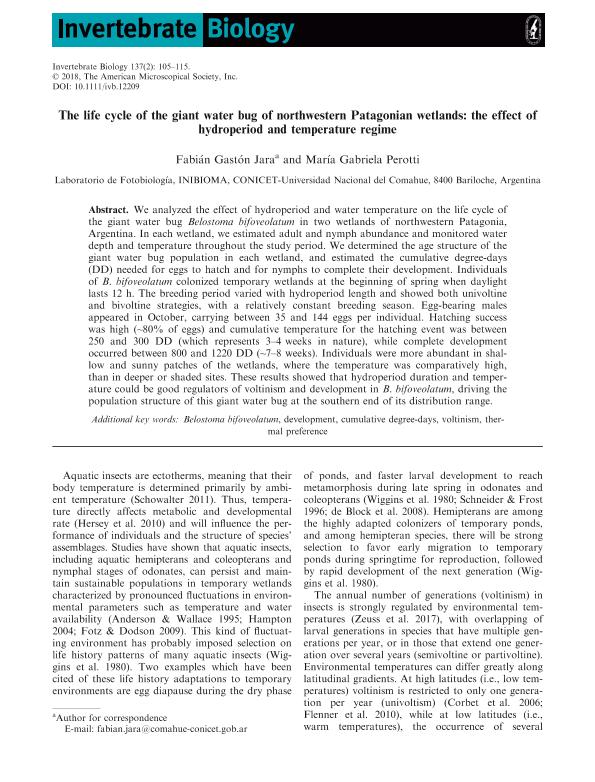Artículo
The life cycle of the giant water bug of northwestern Patagonian wetlands: the effect of hydroperiod and temperature regime
Fecha de publicación:
06/2018
Editorial:
Wiley Blackwell Publishing, Inc
Revista:
Invertebrate Biology
ISSN:
1077-8306
e-ISSN:
1744-7410
Idioma:
Inglés
Tipo de recurso:
Artículo publicado
Clasificación temática:
Resumen
We analyzed the effect of hydroperiod and water temperature on the life cycle of the giant water bug Belostoma bifoveolatum in two wetlands of northwestern Patagonia, Argentina. In each wetland, we estimated adult and nymph abundance and monitored water depth and temperature throughout the study period. We determined the age structure of the giant water bug population in each wetland, and estimated the cumulative degree-days (DD) needed for eggs to hatch and for nymphs to complete their development. Individuals of B. bifoveolatum colonized temporary wetlands at the beginning of spring when daylight lasts 12 h. The breeding period varied with hydroperiod length and showed both univoltine and bivoltine strategies, with a relatively constant breeding season. Egg-bearing males appeared in October, carrying between 35 and 144 eggs per individual. Hatching success was high (~80% of eggs) and cumulative temperature for the hatching event was between 250 and 300 DD (which represents 3–4 weeks in nature), while complete development occurred between 800 and 1220 DD (~7–8 weeks). Individuals were more abundant in shallow and sunny patches of the wetlands, where the temperature was comparatively high, than in deeper or shaded sites. These results showed that hydroperiod duration and temperature could be good regulators of voltinism and development in B. bifoveolatum, driving the population structure of this giant water bug at the southern end of its distribution range.
Archivos asociados
Licencia
Identificadores
Colecciones
Articulos(INIBIOMA)
Articulos de INST. DE INVEST.EN BIODIVERSIDAD Y MEDIOAMBIENTE
Articulos de INST. DE INVEST.EN BIODIVERSIDAD Y MEDIOAMBIENTE
Citación
Jara, Fabian Gaston; Perotti, Maria Gabriela; The life cycle of the giant water bug of northwestern Patagonian wetlands: the effect of hydroperiod and temperature regime; Wiley Blackwell Publishing, Inc; Invertebrate Biology; 137; 2; 6-2018; 105-115
Compartir
Altmétricas




